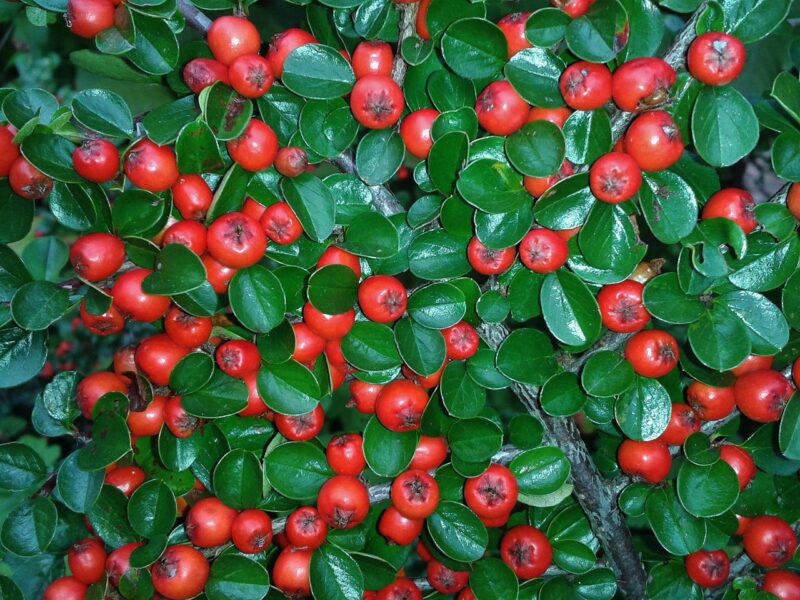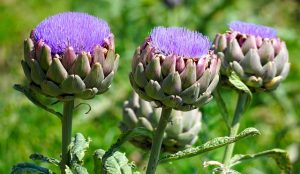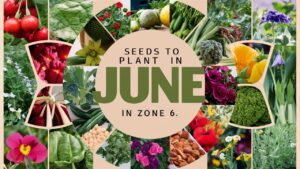Below, we’ll explore captivating species of evergreen plants that feature brilliant red berries, outlining their characteristics, care, and unique attributes.
English Holly (Ilex aquifolium)
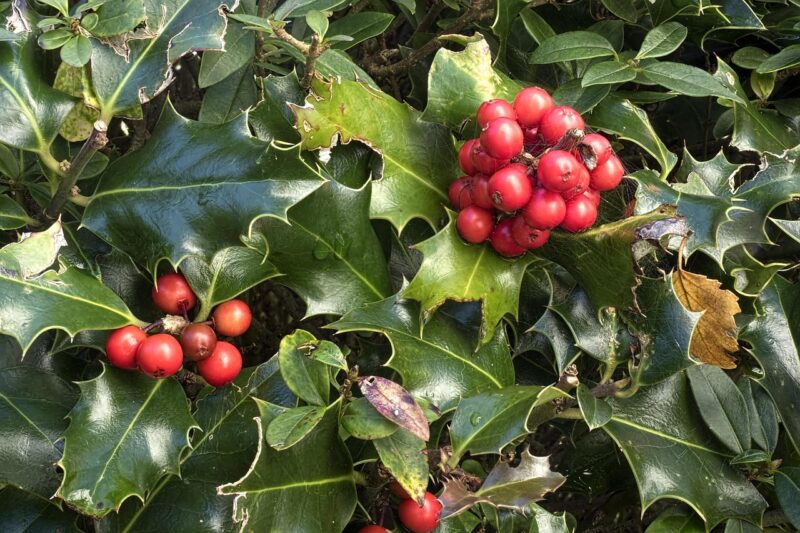
English Holly, a classic symbol of Christmas, showcases glossy green leaves punctuated with striking red berries. This evergreen shrub can grow between 15 to 30 feet tall, making it an excellent choice for hedges or standalone specimens. The serrated leaves offer a distinct contrast against the vibrant berries, which typically appear in clusters and ripen in the fall.
Grown for its ornamental beauty, English Holly prefers well-drained soil and partial to full sunlight. It’s also a resilient plant, thriving in a variety of soil types. As a bonus, the berries are an important food source for birds during the winter months, making it a wildlife-friendly choice. Yet, it’s crucial to note that while the berries attract birds, they are toxic to humans if ingested.
Spotted Laurel (Aucuba japonica)
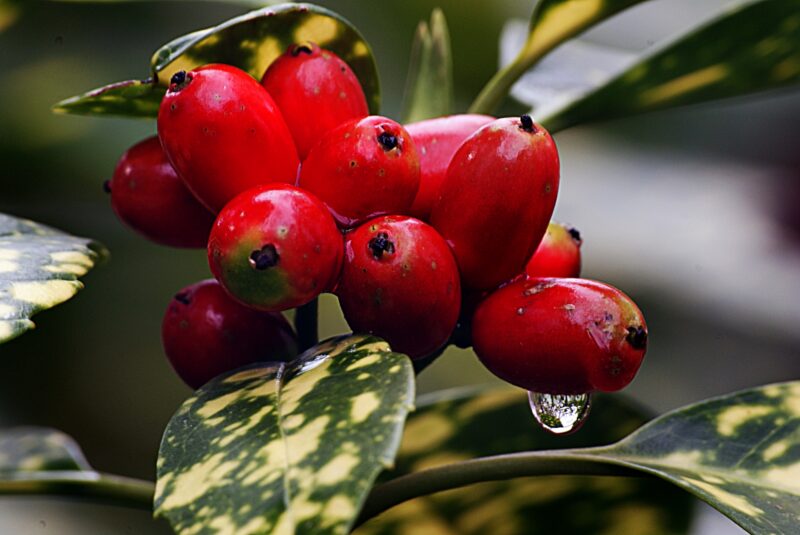
Spotted Laurel, with its bold leaves covered in yellowish spots, is more than just a visually striking plant. When in bloom, it presents small clusters of red berries that add intrigue and color to shaded areas of your garden. The Spotted Laurel is a tolerable plant, capable of flourishing in low-light conditions, making it ideal for gardens where sunlight is scarce.
Typically reaching a height of 6 to 10 feet, it has a bushy growth habit, making it suitable as a hedge or foundation planting. The bright red berries appear in the fall and persist into winter, offering valuable sustenance for birds and other wildlife. Its adaptability to different soils and moisture levels, combined with its low-maintenance nature, makes Spotted Laurel a favorite among gardeners seeking an attractive yet resilient plant.
Heavenly Bamboo (Nandina domestica)
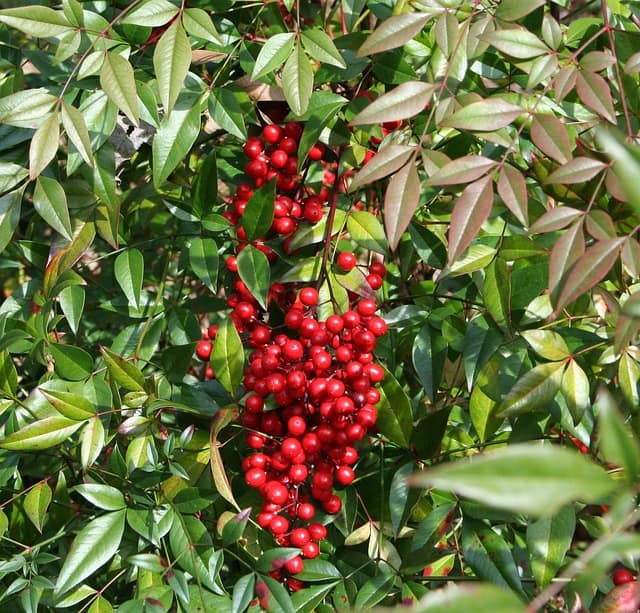
Though called “Heavenly Bamboo,” Nandina domestica isn’t actually a bamboo at all. It’s a stunning evergreen shrub that possesses striking red berries, lending it a place of honor in winter gardens. This plant showcases lush, feathery foliage that exhibits colors ranging from bright green to vibrant red and purple as the seasons change.
Heavenly Bamboo can grow between 3 to 8 feet tall, and its bushy form allows for variety in landscape designs, whether used as a border plant or focal point. The berries, which ripen in the fall, are not only visually appealing but also attract a variety of birds and other wildlife. Care is minimal, as this hardy plant can adapt to various soil conditions; however, it thrives best in well-drained soils. While generally tolerant of different climates, it may not be suitable for climates with extreme cold.
Chilean Guava (Ugni molinae)
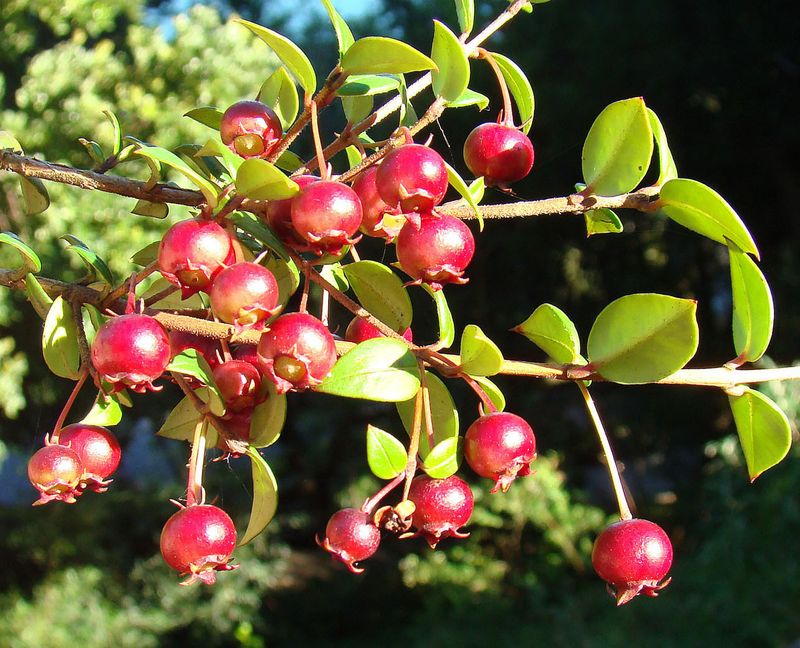
Chilean Guava is a lesser-known gem that deserves more attention in the world of ornamental plants. This evergreen shrub is particularly praised for its sweet, edible red berries that often attract the interest of gardeners looking for dual-purpose plants—those that offer beauty while also providing edible produce.
Typically reaching about 5 to 10 feet in height, Chilean Guava features opulent, glossy leaves and fragrant white flowers that bloom in summer, followed by clusters of bright red berries in autumn. The berries are not only delightful to birds and other wildlife but also delicious for human consumption, often being used in jams and jellies. Preferring well-drained, acidic soil, this plant is quite adaptable but thrives best in milder climates, making it an excellent choice for those living in warmer regions.
Bearberry Cotoneaster (Cotoneaster dammeri)
Bearberry Cotoneaster is a low-growing, sprawling evergreen that features small, bright red berries that persist throughout the winter. This plant displays a charming prostrate growth habit, making it an ideal ground cover for areas that may otherwise be difficult to cultivate.
Reaching a height of only 1 to 2 feet, this species beautifully covers slopes due to its creeping nature and offers dynamic texture to any landscape design. Bearberry Cotoneaster is robust and can thrive in a range of soil types, including poor soils, often proving resistant to drought conditions. The berries provide sustenance to birds in the colder months, making it not only a practical choice but also an eco-friendly one, supporting local wildlife.
English Yew (Taxus baccata ‘Repens Aurea’)
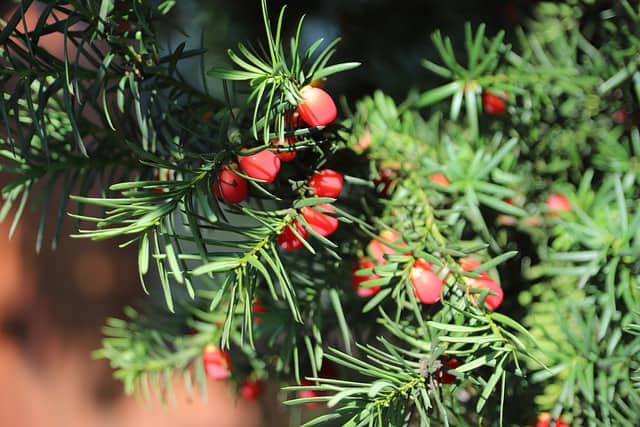
The English Yew is a quintessential evergreen, valued for its tolerance and versatility in landscaping. The ‘Repens Aurea’ variety stands out due to its gold-tipped foliage that brings a unique brightness to gardens year-round. This low-growing yew develops small, red berries that add a pop of color as the foliage fades in winter.
This cultivar tends to stay close to the ground, typically reaching heights of 1 to 2 feet while spreading up to 6 feet wide, making it an excellent choice for ground cover or for softening edges in the garden. English Yews prefer well-drained soils and partial shade but can withstand a range of conditions. The berries are seldom eaten by birds, as they require truly ripe fruit for consumption, but they add color and interest to winter landscapes.
Korean Barberry (Berberis koreana)
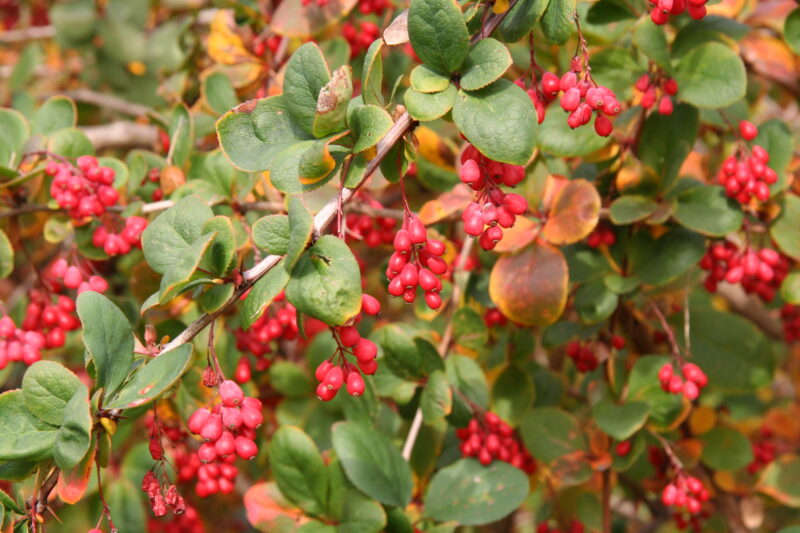
The Korean Barberry is an eye-catching evergreen shrub that provides year-round interest with its beautiful red berries and thorny branches. This plant is exceptional for creating natural barriers due to its dense growth habit and thorns, which can deter intruders while adding a touch of beauty to your landscape.
Typically growing between 3 to 4 feet tall, Korean Barberry is hardy in various soil conditions and light exposure. Its small yellow flowers bloom in spring, followed by clusters of vibrant red berries in the fall that persist well into winter. These berries attract birds, making it a wildlife-friendly selection. Whether used in hedges, borders, or as a specimen plant, the Korean Barberry is an excellent choice for low-maintenance, resilient gardening.
Strawberry Tree (Arbutus unedo)
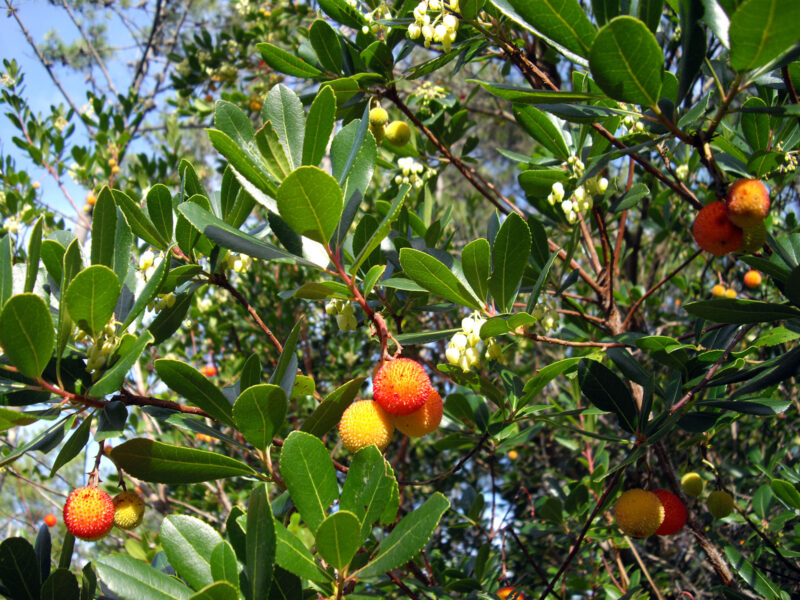
The Strawberry Tree is a captivating evergreen that pairs its unique, strawberry-like fruit with charming white flowers that bloom in fall and into winter. While the berries are not actually true strawberries, their bright red color gives a playful touch to gardens, particularly when clustered against the tree’s sturdy branches.
Reaching heights of 10 to 20 feet, the Strawberry Tree has a lovely, spreading habit that can serve as a focal point in a garden setting. It thrives in well-drained soils and can tolerate drought conditions once established. Its berries are not especially desirable for human consumption, but they attract numerous bird species. In fall, both the fruit and flowers create a stunning visual display, contributing significantly to the garden’s overall beauty throughout the year.
Scarlet Firethorn (Pyracantha coccinea ‘Red Cushion’)
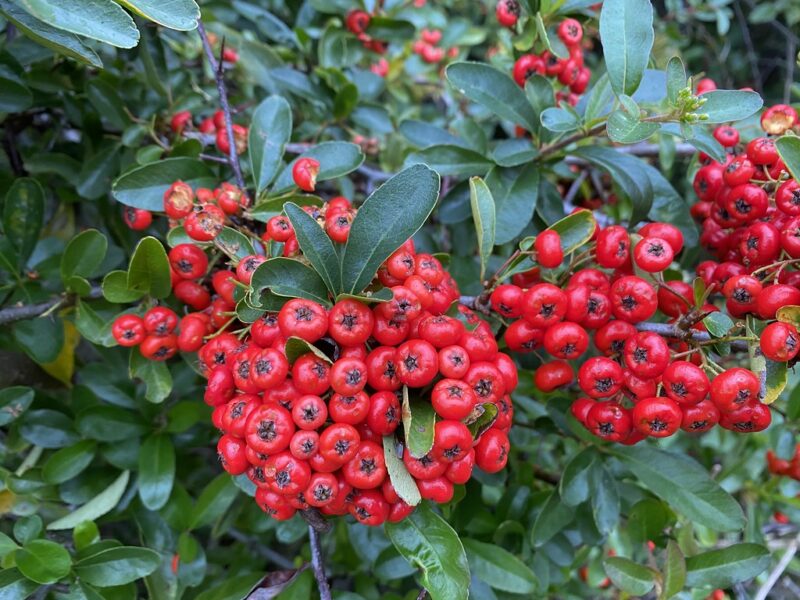
The ‘Red Cushion’ Scarlet Firethorn is a delightful evergreen shrub bursting with colorful red berries that appear in abundance. Known for its dense, thorny branches, this plant serves a dual purpose—acting as an effective deterrent against wildlife and providing food for birds.
Typically growing to a height of about 3 to 4 feet, this compact variety maintains an appealing rounded shape that works well as a hedge or foundation plant. It thrives best in full sunlight and well-drained soils, making it adaptable to various garden environments. The clusters of red berries are an attractive feature that persists through winter, offering sustenance to birds and graphical appeal as snows begin to fall.
Evergreen Dogwood (Cornus capitata)
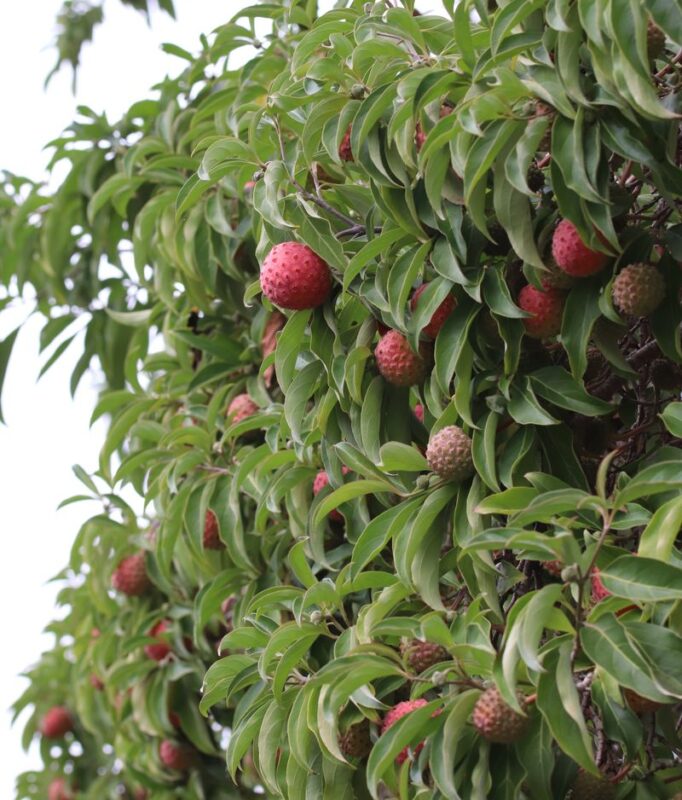
Evergreen Dogwood, also known as the Himalayan Dogwood, is a delightful multifunctional evergreen. Its impressive stature can reach up to 30 feet, and it’s adorned with beautiful, creamy flowers that appear in spring, adding an exquisite layer of texture and form to your garden. By late fall, clusters of red berries develop, providing an eye-catching contrast against the plant’s green leaves.
The ornamental value of Evergreen Dogwood lies not only in its floral displays but also in its abundant berries that attract birds and other wildlife. This tree prefers well-drained soil and does best in mild climates where it can receive ample sunlight. Its elegant form and berry-rich offerings make it a fantastic choice for those looking to create a diverse, wildlife-friendly landscape.
Japanese Skimmia (Skimmia japonica)
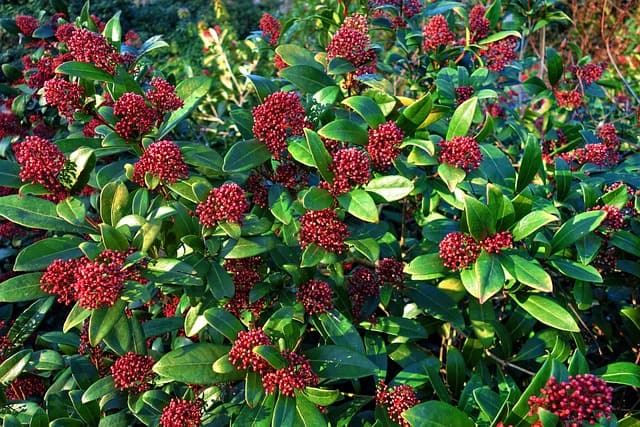
Japanese Skimmia is widely admired for its aromatic leaves and vibrant red berries, which dot its compact form throughout winter. This evergreen shrub remains relatively low, typically reaching heights of 2 to 4 feet, making it an elegant addition to borders, rock gardens, or container displays.
The small white flowers that emerge in spring contribute to the plant’s allure while being appreciated for their sweet fragrance. Notably, Japanese Skimmia berries require pollination; thus, pairing a male and female plant is vital for berry production. Preferring partial shade and well-drained soils, this plant thrives in gardens seeking a touch of elegance while attracting local wildlife with its plentiful berries.
Peruvian Peppertree (Schinus molle)
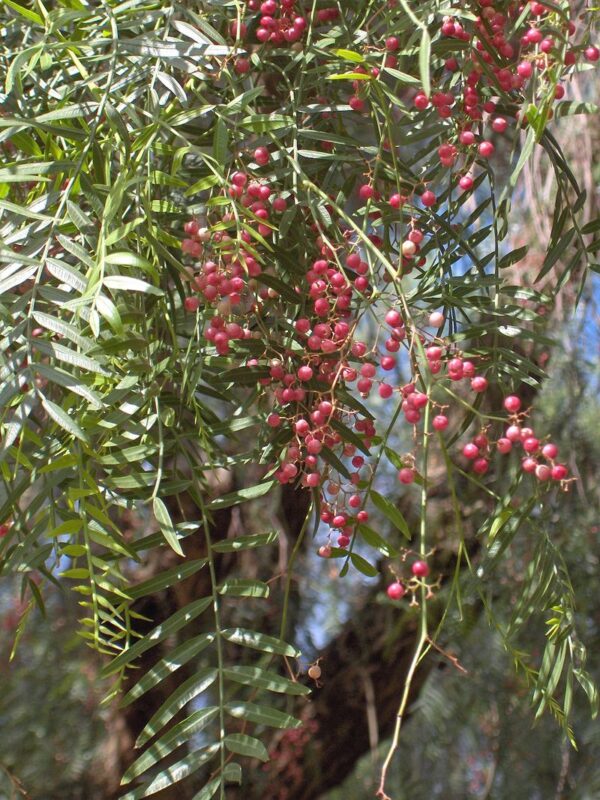
The Peruvian Peppertree is famed for its cascading branches adorned with shiny, fern-like leaves and clusters of red berries that emerge in late summer. As a versatile evergreen, this tree grows up to 20 feet high, offering a unique appearance perfect for various landscapes.
Considered adaptable, the Peruvian Peppertree flourishes in dry, well-drained soils and is known for its drought-resistant nature once established. While the berries are not commonly consumed by humans, they add visual appeal and are known to attract various bird species. Moreover, the leathery leaves provide a lush backdrop, making it a striking choice for gardeners aiming to bring winter interest into their outdoor spaces.



